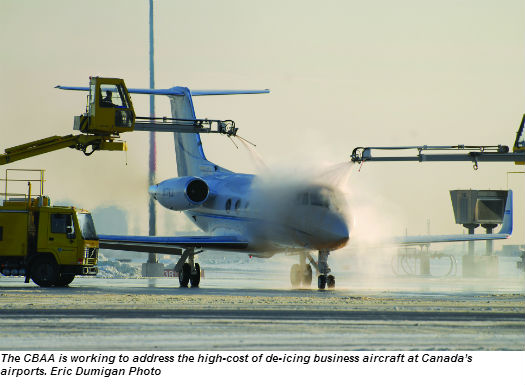by Ken Pole | March 12, 2014
Estimated reading time 6 minutes, 3 seconds.
Ice can be deadly for aircraft, especially on more modern laminar-flow wing designs, which tend to be intolerant of even the thinnest build-up. And, as operators throughout North America have learned during this difficult winter, the cost of dealing with ice isn’t cheap.
The business aviation community seems particularly hard-hit. Canadian Business Aviation Association (CBAA) members, which account for 18 to 20 per cent of movements tracked by Nav Canada, must pay a premium for de-icing services at many larger airports. This is because the major carriers, sanctioned by local airport authorities, form partnerships in which service providers charge major carriers one fee—and everyone else sometimes double or triple that rate.
It’s an issue CBAA president Rudy Toering has been wrestling with since he took the helm of the association last summer. “In Canada, unfortunately, the major airlines have created monopolistic (de-icing) consortiums,” Toering told Canadian Skies. The annual fee for individual carriers can be up to $70,000 at each airport. In return, carriers have priority. “Their models are totally against general and business aviation.”
In Alberta, a continuing hotbed of business aviation, there are striking differences in how the major international airports in Edmonton and Calgary handle de-icing. Toering said that in Edmonton, the consortium with a central de-icing facility (CDI) netted the major carriers a $1.25 million surplus in one year. It’s a different story in Calgary, where the majors are de-iced at the gates, while others are deiced separately, and “they’re actually installing a pad specifically for business aviation.”
A fundamental contrast between the two airports is that while the airport authority in Edmonton opted not to exercise its veto on the consortium board, its Calgary counterpart told the airlines that separating the majors from other users was preferable. The latter is “a very responsible position,” according to Toering.
Meanwhile, at the country’s biggest hub, Toronto’s Lester B. Pearson International, if flight arrivals and departures slow down, or, worse, shut down, the domino effect can be horrendous.
John Sharp, associate director, air service development at the Greater Toronto Airports Authority (GTAA), told Canadian Skies that users’ de-icing needs are accommodated by a centralized de-icing facility offering six pads. In addition, light frost sprays are permitted in certain areas at the airport, and clients with access to hangar space will store aircraft during inclement weather. On occasion, when the icing situation gets really extreme, the GTAA implements a “departure metering program,” which thins the overall flow of aircraft activity to match conditions and available resources. “In these circumstances, business aviation requiring de-icing services may be delayed, as we have to be mindful of the impacts of much larger aircraft and the pressure it places on our terminals,” Sharp explained. “If our business aviation clients have access to one, they can hangar their aircraft, or do light frost sprays and they’re good to go. But, if they have to get out to the deicing pads and we have to thin things out, then we have to make some choices.”
Toering acknowledged that most of his members, and many in the general aviation community, have hangars at their home airports. “But what about the guy who flies to Ottawa, where he doesn’t have a hangar?” he countered. “That’s the sort of situation we have to keep in mind.” There also can be “tremendous overspray” on smaller aircraft which, although recovered and recycled, is a cost; and, if there’s too long of a delay on the ramp or taxiway, another de-icing might be required.
That leaves command pilots, with final say under the Canadian Aviation Regulations, to explain to their employers why they authorized a bill which Toering said can be “tens of thousands” of dollars. He said, unfortunately, some have the perception that “if the guy can afford his airplane and everything else, what’s an extra $20,000?”
His answer is that the owners “ran their finances properly and were frugal, and they set up their companies to be that way. They run their flight department the same way, and if they see an unfair charge, they’ll challenge it. It’s all about running a sound business.”
Toering said that “normal rates for de-icing should be around $5 per litre, and you’re getting into that $13 area for our members; that’s . . . gouging.”
So why not take it to the federal Competition Bureau? The Air Transport Association of Canada (ATAC) evidently has done just that; and although the Bureau said it cannot legally even confirm receiving the complaint, Toering said many ATAC members are “stuck as well” by de-icing premiums.
“It doesn’t need to be that way,” he said. “I’m looking for a fair playing field. If we’re not using a phenomenal amount of fluid and if the major portions of the cost are attributed to the airlines, don’t try to make money off the backs of the rest of us.”

